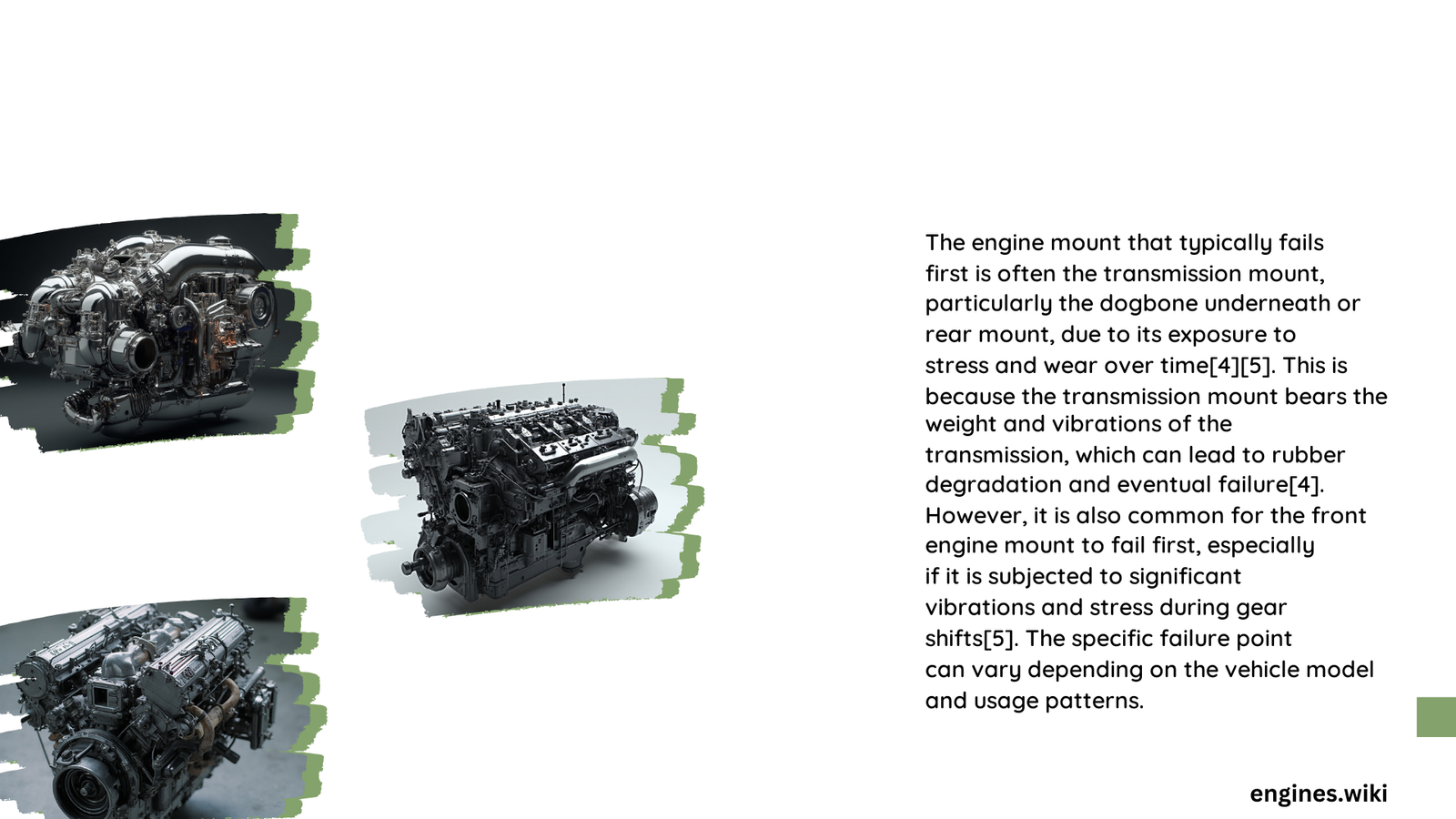Engine mounts play a crucial role in vehicle performance and comfort. They secure the engine to the frame, absorb vibrations, and prevent excessive movement. However, these components wear over time, leading to potential failures. Understanding which engine mount fails first can help vehicle owners anticipate maintenance needs and prevent more serious issues.
What Are the Most Common Types of Engine Mounts?
Engine mounts come in various types, each with its own characteristics:
- Rubber Mounts
- Most common and affordable
- Typical lifespan: 5-7 years or 50,000-80,000 miles
-
Prone to degradation from heat and oil exposure
-
Polyurethane Mounts
- More durable than rubber
- Longer lifespan, but exact duration varies
-
Can transmit more vibration to the vehicle
-
Hydraulic or Active Mounts
- Complex design with fluid-filled chambers
- Better vibration control
- Similar lifespan to rubber mounts despite higher cost
Which Engine Mount Typically Fails First?

In most vehicles, including popular brands like Mercedes, the front engine mount is often the first to fail. This is due to several factors:
- Higher stress from engine movement
- Greater exposure to heat
- More frequent compression and expansion cycles
However, the specific mount that fails first can vary depending on:
- Vehicle design
- Driving conditions
- Maintenance history
Why Does the Front Engine Mount Fail More Frequently?
The front engine mount bears the brunt of engine forces for several reasons:
- Engine Torque: It counteracts the rotational force of the engine, especially during acceleration.
- Weight Distribution: In many vehicles, more weight is concentrated on the front mount.
- Heat Exposure: Proximity to hot engine components accelerates wear.
- Road Impacts: It absorbs more shock from bumps and potholes.
What Are the Signs of a Failing Engine Mount?
Recognizing the symptoms of a failing engine mount is crucial for timely replacement:
- Increased Vibrations
- Felt through the steering wheel, floor, or entire vehicle
-
Particularly noticeable at idle or during acceleration
-
Unusual Noises
- Clunking or banging sounds from the engine bay
-
More pronounced during engine start, idle, or gear shifts
-
Excessive Engine Movement
- Visible engine shifting or sagging in the compartment
-
Noticeable during acceleration or braking
-
Performance Issues
- Jerky movements when speeding up
-
Poor handling, especially during turns
-
Visual Indicators
- Cracks or tears in the mount
- Signs of fluid leakage (for hydraulic mounts)
How Long Do Engine Mounts Typically Last?
The lifespan of engine mounts can vary significantly based on several factors:
| Mount Type | Average Lifespan | Influencing Factors |
|---|---|---|
| Rubber | 5-7 years / 50,000-80,000 miles | Heat, oil exposure, driving conditions |
| Polyurethane | Longer than rubber (exact duration varies) | Driving style, vehicle type |
| Hydraulic | Similar to rubber, despite higher cost | Complexity of design, maintenance |
Factors affecting engine mount longevity:
- Driving habits (aggressive vs. conservative)
- Road conditions (smooth highways vs. rough terrain)
- Climate (extreme temperatures can accelerate wear)
- Vehicle maintenance practices
Can Driving Habits Affect Which Engine Mount Fails First?
Driving habits play a significant role in engine mount wear:
- Aggressive Acceleration
- Puts more stress on the front mount
-
Can lead to premature failure
-
Frequent Short Trips
- Constant heating and cooling cycles stress the mounts
-
More common in urban driving
-
Heavy Loads
- Increases strain on all mounts
-
Front mount often bears the most weight
-
Off-Road Driving
- Exposes mounts to more vibration and impact
- Can accelerate wear on all mounts
How Can You Extend the Life of Engine Mounts?
While engine mount failure is inevitable, certain practices can prolong their lifespan:
- Regular Inspections
- Check for signs of wear during routine maintenance
-
Address minor issues before they become major problems
-
Smooth Driving
- Avoid aggressive acceleration and braking
-
Reduce stress on engine mounts
-
Proper Alignment
- Ensure correct engine alignment during mount replacement
-
Prevents uneven wear on mounts
-
Quality Replacements
- Use OEM or high-quality aftermarket mounts
-
Invest in durability for long-term savings
-
Address Fluid Leaks
- Prevent oil or coolant from degrading rubber mounts
- Maintain the integrity of hydraulic mounts
What Are the Consequences of Ignoring a Failed Engine Mount?
Neglecting a failed engine mount can lead to serious issues:
- Engine Damage
- Misalignment can cause wear on belts, hoses, and other components
-
Potential for catastrophic engine failure in extreme cases
-
Safety Hazards
- Unpredictable engine movement can affect vehicle control
-
Increased risk of accidents, especially during emergency maneuvers
-
Increased Repair Costs
- Damage to surrounding components
-
Potential for more extensive engine repairs
-
Reduced Fuel Efficiency
- Engine misalignment can affect performance
-
Increased vibration leads to higher fuel consumption
-
Comfort Issues
- Excessive noise and vibration
- Decreased overall driving experience
Understanding which engine mount fails first and recognizing the signs of failure can help vehicle owners maintain their cars effectively. By addressing mount issues promptly, drivers can ensure better performance, safety, and longevity of their vehicles.
References:
1. MBWorld.org Forums
2. BobIsTheOilGuy
3. J.D. Power
